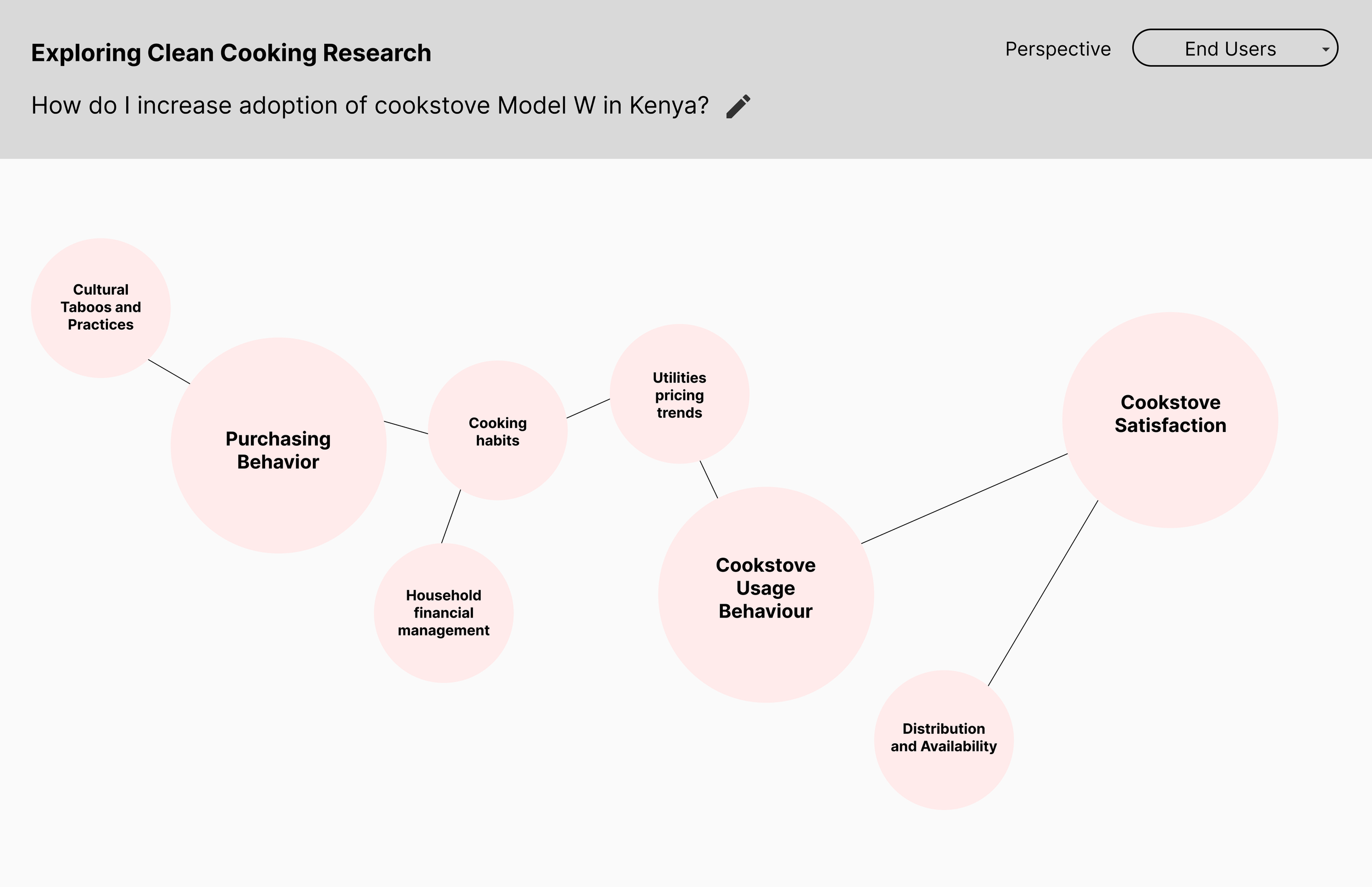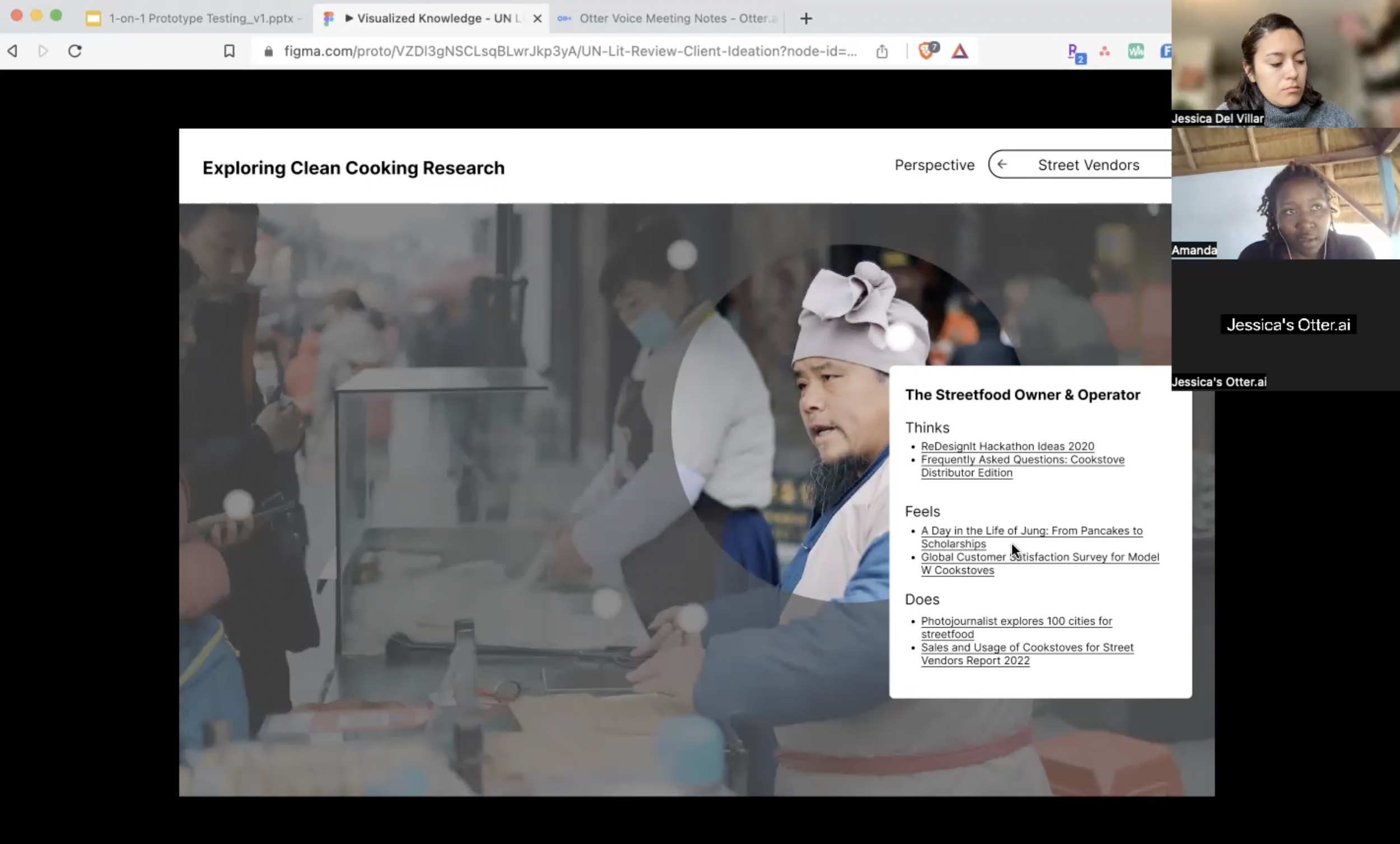Clean Cooking
Alliance
A RESEARCH AND DESIGN PROJECT
Worked with a team to research and design a library for the Clean Cooking Alliance, a project of the United Nations.
OVERVIEW
Background: The Clean Cooking Alliance works to make clean cooking accessible to over 2 billion people. Our team was tasked with designing a tool that allowed practitioners, researchers, and businesses to explore themes and gaps from a human-centered approach while addressing their business needs.
Problem: Scattered and missing research makes it difficult for stakeholders to understand their product needs from a human-centered perspective.
Tools: Figma, Miro
Role: UX Researcher & Designer
Team: Strategy Lead, Lead Designer
UNDERSTANDING THE PROBLEM
RESEARCH REVIEW & SYNTHESIS
We begun this process by reviewing dozens of research articles to pull primary themes and ideas within current literature to identify gaps and missing information.
END USER RESEARCH
In addition to reviewing literature, we conducted initial interviews with 2 end users to understand who we were building for.
KEY INSIGHTS
1
2
Enterprises ask questions from the frame of business needs and don’t see the value in understanding customer needs
Research needs to be made more digestible. For enterprises, this means they can get to the answer they are looking for more quickly.
HOW MIGHT WE…
1
2
Inspire enterprise teams to see value in human centered design within their existing business processes?
Categorize research data in a way that helps enterprise teams zero in on the information they are looking for, while encouraging a human-centered approach?
After consulting with the client, we decided to focus on insight #2.
DIRECTOR OF BUSINESS DEVELOPMENT
“This is business and there’s money to be made here; the research that I encounter needs to be easily digestible and tie into our business goals.”
DIRECTOR OF SPECIAL PROGRAMS
"I want to understand why people cook the way that they do. Why do they use gas and how can we get them to use more?”
IDEATE
OUR NORTH STAR
How might we categorize research data in a way that helps enterprise teams zero in on the information they are looking for, while encouraging a human-centered approach?
LO-FI PROTOTYPES
Our team brainstormed 4 concepts to later test with end users during a co-creation session and user interviews.
A: EXPLORING RESEARCH IN SCENE
Location based tool that presents research from a human-centered perspective
B: RESEARCH GENIE
Search engine that refines research questions
C: WEB OF KNOWLEDGE
Thematic breakdown of research that visualizes connections between topics
D: RESEARCH COMMUNITY
Peer-to-peer network for knowledge sharing and collective brainstorming
TESTING
CO-CREATION SESSION
The next step was to test the 4 lo-fi prototypes during a co-creation session with 9 key stakeholders. Users included marketing directors, product managers, and researchers.
USER INTERVIEWS
Following the co-creation session, I led in-depth, individual interviews with 4 users across the globe.
KEY TAKEAWAYS
Based on the co-creation session and user interviews, our team came away with three key takeaways.
Enterprise team’s priority is to find the information they need as quickly as possible.
Users appreciate seeing search results that are human-centered, but they don’t want to have to actively frame their questions this way.
Visuals are very helpful for contextualizing information
DESIGN
INTRODUCING CLEAN COOKING SMART LIBRARY
Find relevant research with ease while being encouraged to explore emerging information.
Clean Cooking Smart Library is a research tool that hones in on sector-specific research and resources. It allows researchers, enterprises, distributors, and other key players in the clean cooking sector to ask questions and quickly find answers, while being able to explore different perspectives with the goal of increasing human-centered perspectives toward designing cooking solutions.
KEY FEATURES
1
2
Asking A Question
A Kenya-based clean cookstove and energy company is looking to expanding into Uganda. The company’s primary researcher, Nadia, is searching for concrete data to understand fuel usage trends in from the past 5 years. Because Nadia is short on time, she needs a quick answer. Nadia opens Smart Library and types in her question directly into the search bar.
Exploring by Region
Sometimes Nadia has extra time and wants to learn about Uganda more broadly. By having a well-rounded understanding of Uganda, Nadia’s company is able to create a more useful design and be competitive in this emerging market. Nadia chooses the “Explore by Region” feature in the SmartLibrary.
3
Exploring by Customer Lifecycle
"Sometimes you're just looking for like a fact or something to prove an assumption that you're trying to build into a grant proposal or a customer pitch right?"
-Business Development Researcher
When Nadia’s company is developing or refining a product. They are more interested in research related to customer engagement and retention. Nadia chooses to the “Explore by Customer Lifecycle” feature in SmartLibrary.
"...we're also trying to think of how do we get to interact with customers without...actually meeting them because you can't scale this customer visit."
-Product Manager
"You want to make sure that whatever you're thinking of bringing to people they actually need it [and] they actually see the need"
-Director, clean cooking appliances
RETROSPECTIVE
WHAT WENT WELL
✅ Gathering insights and feedback from end users was very helpful in shaping the design
✅ Collaborating with a team helped maximize each person’s strength and impact on the project
NEXT TIME
It would have been great to have been part of the implementation phase of this design and continue iterating on features.
NEXT PROJECT














